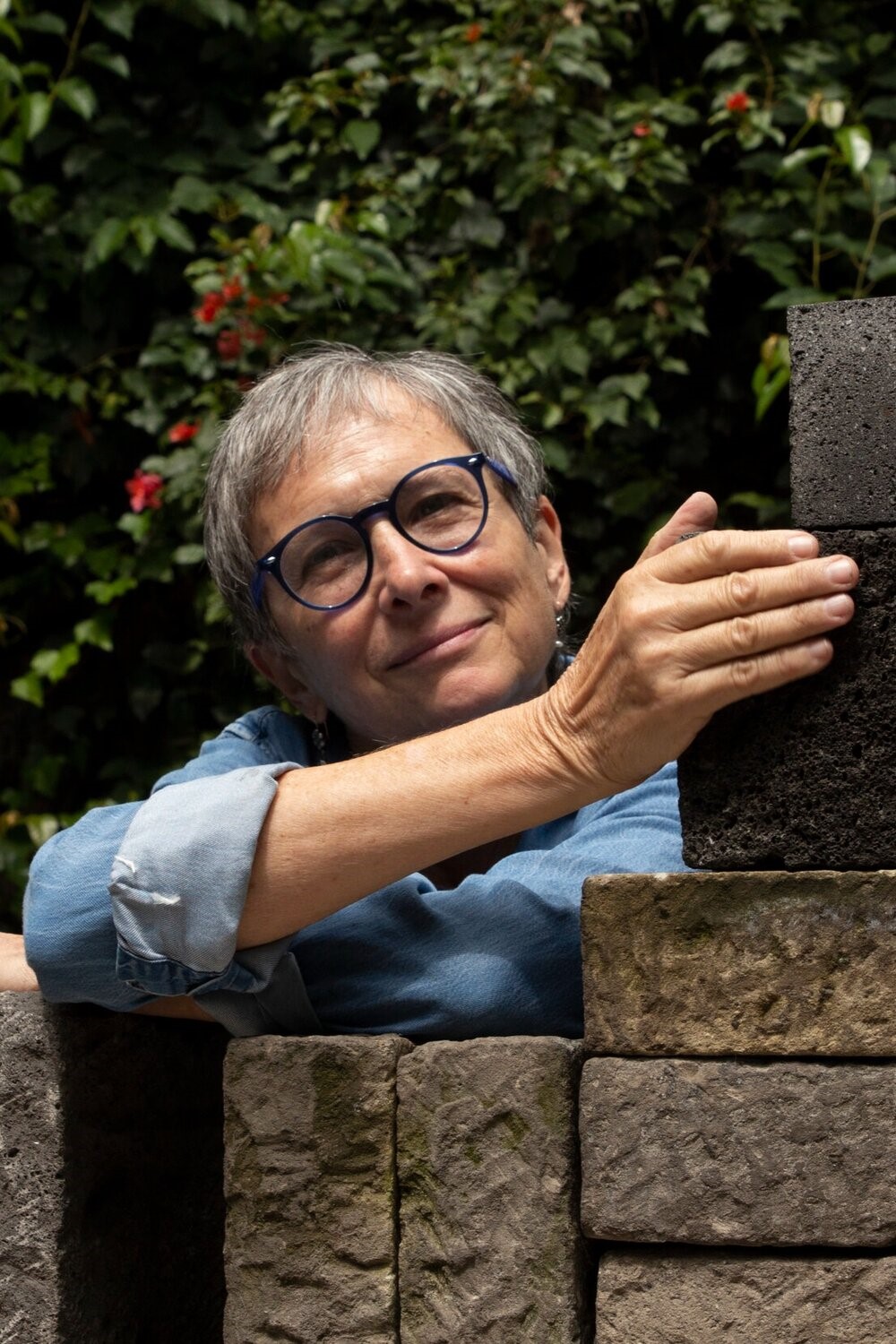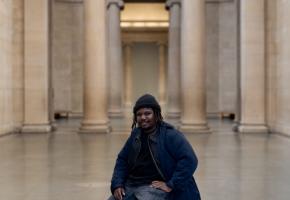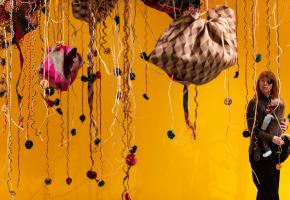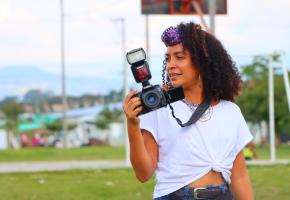Perla Krauze is delighted to have returned to London with some new work. Having graduated from the Escuela Nacional de Artes Plásticas at the Autonomous National University in Mexico, where she studied graphics, she first came to the UK in 1977, with her ex-husband architect Isaac Broid. A friend, having seen some of her experimental embroideries, suggested she contact the director at the Textiles Department Goldsmith’s, this led to her obtaining a Diploma in Textiles.
“There, for the first time, I experienced the English way of engaging with the study [of art], using tutorials and the use of a mini-studio. This was just a little part of a room, where I could leave my things and work at my own pace with a precise theme that I could develop. It was a completely different way of working to Mexico. There we worked with artists in their various workshops, one hour here, two hours there, at their ateliers… I had never had a space of my own before, so for me that was fundamental."
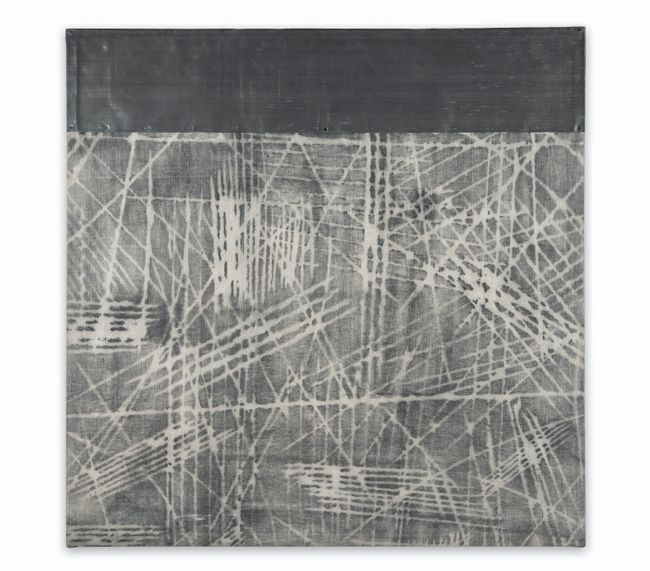
Impronta Tecali #15 - Charcoal, lead and graphite on canvas -
Krauze took a short break from work at that point to return to Mexico and start a family. She began to draw and paint, and began to understand her passion for the three-dimensional sculptural object. A few years later, she was encouraged to get a British Council Scholarship to study Fine Art in England, where she went on to complete an MA in Fine Art at the Chelsea College of Art (1992). She admits this period was key to her development into the artist she is today.
“I began to make installations and sculptures in a very intuitive way. When the first accepted me, they said that although they could not see sculpture yet, I could still join the Painting Department at the college, where I would be free to go ahead with the work I was doing. It was like a precious gift for me. So off I went, with my 9 year old son Daniel and my 12- year old daughter Sofía. It was a huge challenge. I had a wonderful studio in Wandsworth and the children went to a state school where they learnt English, and more about diversity and life. Through [this wonderful system of] tutorials, I began to grow as an artist and explore what 'materials' and ‘space’ meant for me. They encouraged me to put my paintings aside and start working on my more experimental ideas: ‘… that little idea that you left there in the corner…’ They could see a future in it, but they wanted me to find that out for myself.”
During that period, Krauze discovered the magic of experimenting with diverse materials, began introducing lead and some of the ingredients that she still works with today.
“It was a new way of seeing space, of learning how to approach it and the materials. So, it all began there, really, in 1992. The truth is that materials, all of them, convey the memory of a place, they talk about where they came from. For example, the black clay of Oaxaca… It’s an incredible colour, somewhere between a silvery effect like pewter and black. It speaks of Mexico. When I was in the UK, I began to feel the need to talk about Mexico, from another point of view, not just the colour, so much so that people asked me ‘Why don’t you use colour?’ I insisted that Mexico is not only colour, it’s also black and white, it’s the shadows, even the pyramids…. Materials in Mexico talk about the place.”
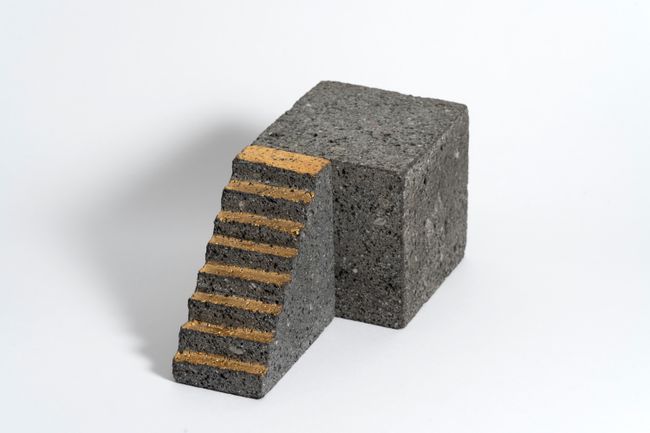
Escalera #3 - Volvanic stone, gold leaf painting
As a young artist, she used to visit the buildings of modernist architects that have left their imprint on Mexico. Among them, Le Corbusier, Max Cetto, and Luis Barragán, as well artists like Mathias Goeritz with his monumental zig zags works or the architect Dimitris Pikionis with his version of paving floors with local stone. Despite all these connections, as Krauze developed her own personal language, she discovered that it was Mexico itself that was her most profound influence and inspiration. In particular, having spent a large part of her childhood in an area called El Pedregal, where she absorbed the very essence of the place.
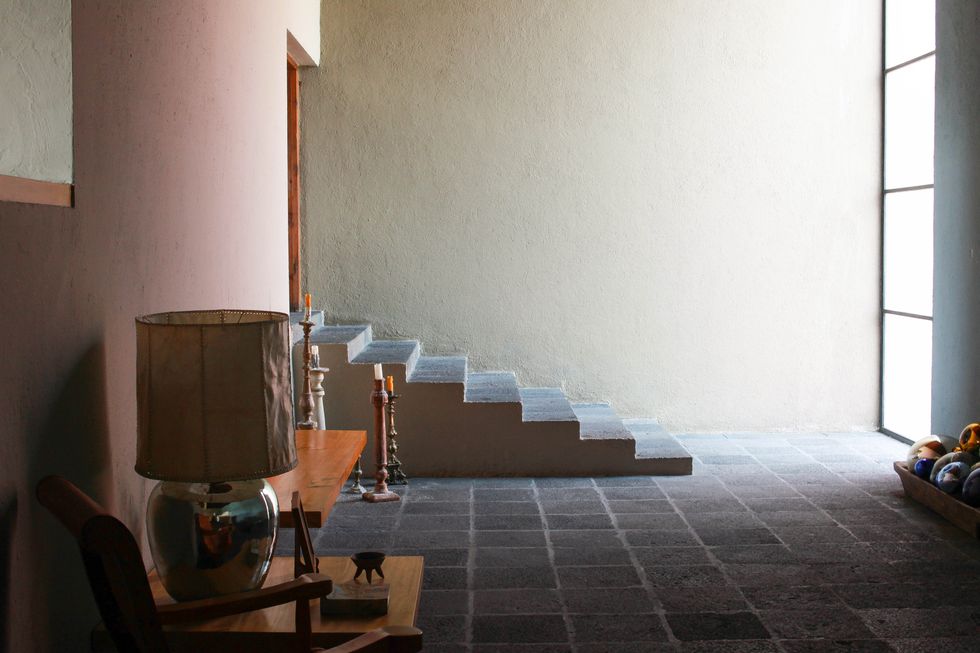
Casa Luis Barragán - Mexico-
This large area known as El Pedregal, on the edges of Mexico City, is a largely unknown enclave despite its mythical and primordial qualities. It harbours archaeological sites of profound importance, including some of the oldest ruins in the Valley of Mexico, Cuicuilco and Coplico. This valley is a highlands plateau in central Mexico, surrounded by mountains and volcanoes and was the central heart of several pre-Colombian civilizations, including the Toltec and the Aztecs, The 1700s eruption of the Xitle volcano, created massive rivers of lava that led to the area being abandoned for a very long time. Having grown up close to that wild world of El Pedregal, Krauze determined to create works that expressed its essence, as that of Mexico itself, when she returned home in 1994.
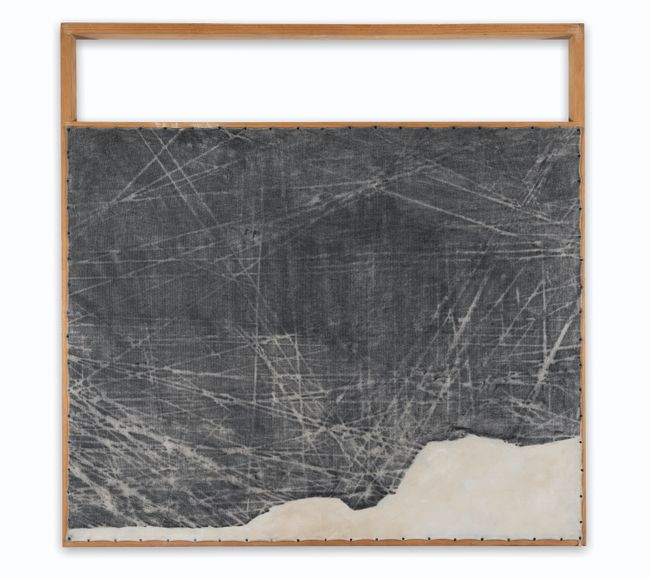
Impronta Tecali #16- Charcoal, graphite on canvas
When she was doing her research for an exhibition in Puebla, she came across people working volcanic rock and marble, which she began to use. Also, while she was there, she began to experiment with ways to express the traces, cracks & marks on stones, recording the vestiges of what had taken place on those surfaces. Using a ‘frottage’ technique, with a huge thick stick of graphite, she took down these traces, with the crevices and cuts. The results also echo other ‘lines that speak of the past', such as the Nazca lines of Perú.
“There are pieces [I’ve made] that talk about Mexico, through that black porous [volcanic] material, sometimes laminated and attached to staircases or worked in other ways. I’m talking about a memory of Mexico through these sculptures. Something happens that makes me want to put them together. I wanted to make that place [the Pedregal] more visible. The word ‘Time’ as well as ‘Memory.’ resonate. I used to take huge canvases and place them on the ground, wherever there were cracks and marks, be they in a parking lot or a pavement. I could see that those little crevices talked about the past… traces that are often overlooked, so I made a record of them…it’s not only the textures, it’s the vestiges of the past, what is left behind. When I was in Puebla, I saw how craftsmen used large stones as a cutting mat, chas chas chas…. Leaving deep marks behind, so I took a large canvas roll and by the metre recorded those marks with my graphite stick… those traces left by the workers and their machines, as they cut the marble by the metre for sale. They began to understand my madness and allowed me to go in and make enormous frottages as big as 2 by 3 metres from these stones, that they then threw away. I sprayed them, then rolled them up and later put them on stretchers to transform them into being prints, drawings, recordings, or something in between... I often add elements, like lead, or oil."
Perla Krauze emphasizes her fascination with lead. It started when she found a discarded fragment in a parking lot in London. She took it back and studied it, learning to appreciate its qualities, its malleability, flexibility, weight and of course, appreciate its extreme toxicity as well! She loves using it (with great caution) because of its specific ‘duality’: -
“… between what is ephemeral and what is permanent, what is natural or artificial, geometric or organic… that is how I see life, full of dualities for good and for bad.”
Certain elements like water, stain the lead leaving indelible marks that cannot be removed. Lead is also fascinating to Krauze, because it was the element that alchemists used to try to transform into gold. Coincidentally, lead (PB 82) and gold (AU 79) sit close to each other on the periodic table of elements and share almost the same atomic weight, both elements that Krauze has incorporated in to her work.
Krauze is aware that her work has been associated with ‘Arte Povera’ (an art movement from the 1960s that took place in Italy) which was characterized by the use of ‘poor’ materials like earth, clothing, paper, or rope to challenge notions of value largely using sculptural forms. For example, Luciano Fabro (1936-2007) in his Pavimento – Tautologia 67, used sheets of newspaper on the floor, temporal, ephemeral and a comment on society. But Krauze is not out to criticize or make political comments, she is rather calling the viewer to feel and understand the essence of Mexico through its most fundamental qualities.
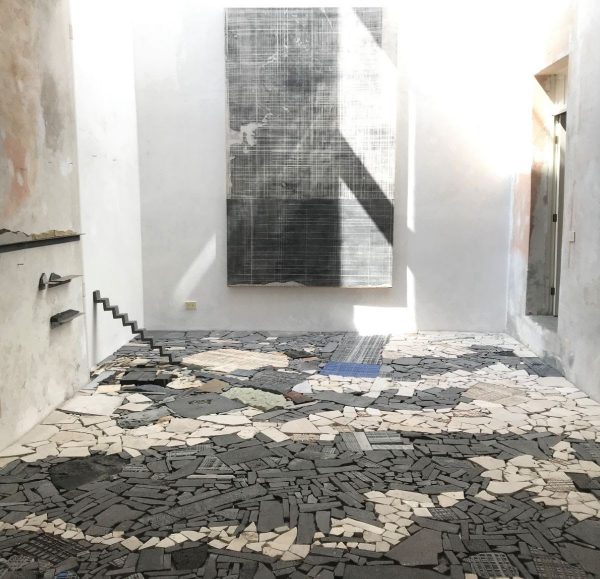
Perla Krauze 's studio in Mexico City.
Her use of fairly modest materials has other connotations entirely. She’s interested in blurring the lines, for instance, by working a slab of volcanic rock as a painting, incorporating other materials such as lead or even oils. She likes to add the element of the detailed way in which she stretches the canvas, transforming it into an ‘object’. Even her time at Goldsmith’s studying textiles and embroidery emerge in the way she chooses to stretch those canvases, whether by sewing or using staples to join the pieces. These details are of importance to her as “… they also speak of ‘memory’.
Krauze, in particular during Covid, found that she once again took up using fabrics, this time with a novel stitching technique, not exactly embroidery but closer to a drawing. She has also set herself a project of drawing one stone a day in charcoal, while she returns to her stitching in a more casual way, working with the ephemeral quality of the material, which, being soft and light, is in stark contrast to the weight of volcanic rock, emphasizing the ‘duality’ elements again.
“Since 1992, staircases are an element I have uses in many ways, be they in a drawing, a painting or a sculpture. They can be small or big enough to go up and down… Sometimes they might take you to a place, or not… you go up or down steps to go into the sky, but not necessarily. This for me, is a transformative process, because stairs can also be lateral paths, so I am creating many horizontal roads along which we must travel. In effect, in my last exhibition I wanted to inhabit the space, not only travel through it gazing up or down as on a stairway, but really entering that space…."
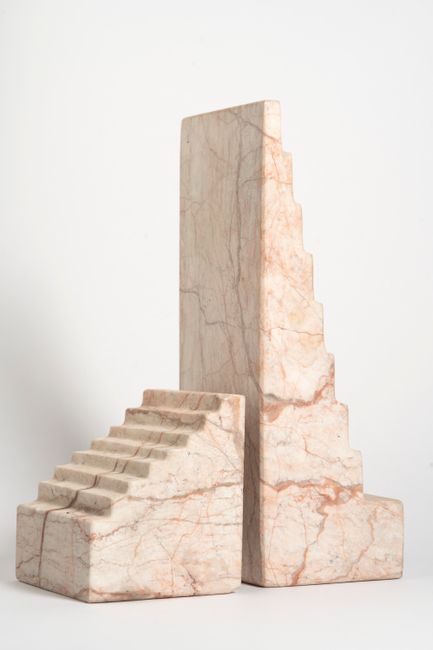
Escalera #1- Pink Marble
Perla Krauze was delighted to be paired with Mimi Jung in this exhibition at the Cadogan Gallery. When she visited the gallery to hang and put up her work, she realized their work resonated with a cohesive quality: -
“I must admit that I was delighted by that closeness. It took me back to my experience with textiles. When I was at the gallery, I could see the crossovers, and, as they say, the ‘warp’ and the ‘weft’, as well as the knots, that were so familiar to me from that time. There are current works of mine that also echo the idea of a warp and a weft, so it was particularly interesting that we coincided in this show and I am so sorry I didn’t get to meet her.”
Perla Krauze & Mimi Jung will be at the Cadogan Gallery in South Kensington from
July 12th to September 3rd 2022.


